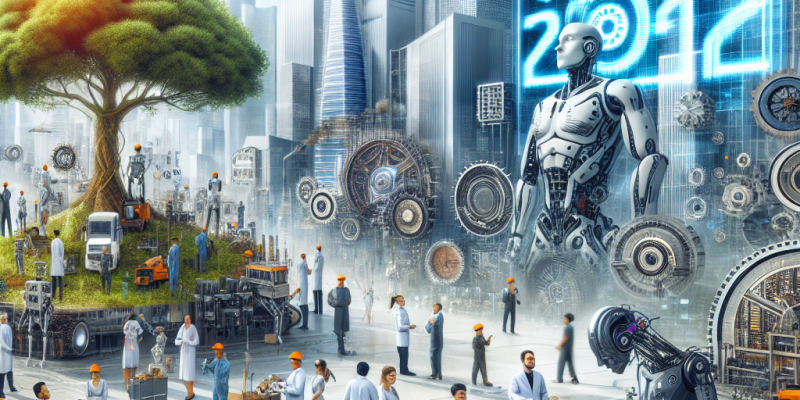The AI Workforce: Embracing Automation while Preserving Jobs in 2024

As we navigate the complexities of the 21st century, the rise of automation and artificial intelligence (AI) continues to provoke passionate discussions about the future of work. In 2024, the integration of AI into the workforce has transformed industries, generated significant efficiencies, and raised critical questions about employment and job preservation. While it is undeniable that automation has the potential to displace certain jobs, it also creates opportunities for innovation, upskilling, and the development of new roles. This article explores the intricate balance of embracing automation while preserving jobs in an increasingly AI-driven economy.
The Growing Role of AI in the Workplace
The adoption of AI technologies across sectors has accelerated due to advancements in machine learning, natural language processing, and robotics. By 2024, businesses are leveraging AI to streamline operations, enhance customer experiences, and drive decision-making processes with unprecedented efficiency. From manufacturing to healthcare, AI applications are optimizing supply chains, predicting patient outcomes, and personalizing services.
However, this progress is not without apprehension. The World Economic Forum’s Future of Jobs Report highlights that millions of jobs may be transformed or displaced due to automation. Roles that involve repetitive tasks or data processing are particularly susceptible, prompting fears of widespread unemployment.
The Silver Lining: Job Creation and Transformation
While the specter of job displacement looms large, a closer examination reveals a more nuanced reality. Historical trends demonstrate that technological advancements often lead to the creation of new jobs. In 2024, the emergence of AI has catalyzed demand for roles that did not exist a decade ago. Positions such as AI ethicists, data curators, and machine learning specialists are in high demand, highlighting the shift towards more complex skill sets.
Moreover, automation augments rather than replaces human labor in many cases. By alleviating workers from routine tasks, AI allows them to focus on higher-value activities that require creativity, critical thinking, and emotional intelligence. This shift presents an opportunity for employees to evolve in their roles and contribute to more strategic initiatives within their organizations.
Upskilling and Reskilling: The Key to a Sustainable Workforce
To successfully navigate the AI landscape, companies must invest in the upskilling and reskilling of their workforce. In 2024, organizations are increasingly recognizing that the key to leveraging AI is not simply replacing human workers but enhancing their capabilities. By providing training programs, mentorship, and access to educational resources, businesses can prepare employees for the roles of the future.
Collaborations between educational institutions and industry leaders are becoming more common, with initiatives aimed at aligning curricula with the skills needed in the AI workforce. This approach ensures that graduates enter the job market equipped with the knowledge and abilities that are in demand, fostering a work culture that values continuous learning.
Ethical Considerations: Fairness and Inclusivity in the AI Economy
As AI systems become more embedded in the workplace, ethical considerations surrounding job displacement and unfair practices gain prominence. It is crucial for organizations to adopt transparent and inclusive AI policies that prioritize fairness, equity, and employment opportunities for all individuals, regardless of their background.
In 2024, many companies are establishing task forces dedicated to addressing ethical implications associated with AI deployment. These teams ensure that AI systems contribute positively to the workforce, mitigate bias, and respect worker rights. By embedding these principles into the fabric of their operations, businesses can foster a culture that values humanity alongside technological advancement.
A Collaborative Future: Humans and AI Working in Tandem
The future of work in 2024 is characterized by collaboration between humans and AI. Rather than viewing AI as a threat, workers and employers are beginning to see it as a partner that enhances human capabilities. AI technologies are augmenting decision-making, providing insights from vast datasets, and assisting with tasks that require precise calculations—freeing up time for employees to engage in more meaningful, creative, and complex work.
This paradigm shift fosters a work environment where employees are empowered to innovate, problem-solve, and contribute to their organizations in ways that were previously unattainable. As companies embrace this collaborative ethos, they pave the way for sustainable growth, improved job satisfaction, and heightened productivity.
Conclusion: A Forward-Looking Approach to the AI Workforce
As we look ahead into 2024, the dialogue around the integration of AI in the workforce continues to evolve. Embracing automation while preserving jobs requires strategic foresight, ethical considerations, and a commitment to continuous learning and adaptation. By investing in workforce development, prioritizing inclusivity, and fostering collaboration between humans and technology, we can create a future where both AI and human labor thrive together.
In this new era, it is possible to harness the power of AI to not only enhance productivity and efficiency but also to uplift the human workforce. The challenge lies not in resisting change but in navigating the complexities that arise from it—ensuring that the benefits of AI are felt across all sectors of society.














